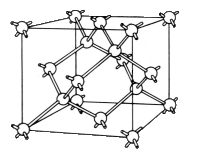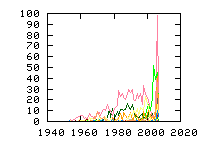Showing
10, 25, 50, 100, 500, 1000, all papers per page.
Sort by:
last publication date,
older publication date,
last update date.
- 1. Solid State Physics 5, 258-319 (1957) , Academic Press, New York (Edited by F. Seitz, D. Turnbull) , “Shallow Impurity States in Silicon and Germanium”, W. KohnI. Introduction (p.258): II. Emprical Properties (p.261): 1. Energy Levels (p.261), a. Ionization Energies, b. Spectra of Excited States, 2. Spin Resonance (p.266), a. Electron Spin Resonance, b. Double Resonance, 3. Static Magnetic Susceptibility (p.271), III. Structure of Donor States (p.271): 4. Conduction Bands of Silicon and Germanium (p.271), a. Silicon, b. Germanium, 5. Effective Mass Theory of Donor States (p.274), a. Single Band Minimum at k=0, b. Several Conduction Band Minima, c. Matrix Elements for Radiative Transitions, 6. Numerical Results and Comparison with Experiments (p.285), a. Energy Levels, b. Wave Functions, 7. Corrections to the Effective Mass Formalism (p.289), a. General Considerations, b. Corrected Wave Functions, c. Comparison with Experiment, IV. Structure of Acceptor States (p.297): 8. Valence Bands of Silicon and Germanium (p.297), a. Silicon, b. Germanium, 9. Effective Mass Equations for Acceptor States (p.300), 10. Approximate Solutions and Comparison with Experiment (p.301) a. Germanium b. Silicon V.Effects of Strains and of Static Electric and Magnetic Fields (p.306): 11. Strains (p.306) a. Donor States, b. Acceptor States, 12. Stark Effect (p.311)
- 2. Phys. Rev. B 9, 4351-4361 (1974) , “EPR study of defects in neutron-irradiated silicon: Quenched-in alignment under <110>-uniaxial stress”, Young-Hoon Lee and James W. CorbettThe stress effect in an EPR study is first treated rigorously in terms of the piezospectroscopic tensor, taking account of the local symmetry of a defect. It is found that the degree of alignment (n?/n?) provides incisive information on the structure of a defect; in general, a... (Read more)
- 3. Phys .Rev. Lett. 32, 271 (1974) , “Observation of Electron Spin Resonance of Negative Ions in Liquid Helium”, Jonathan F. Reichert and Arnold J. DahmWe have observed ESR signals of negative ions in liquid helium. The linewidth and g value have been measured. Electrons injected into helium by field emission from ferromagnetic tips are shown to be polarized. We propose a new technique for the measurement of electron spin polarization. (Read more)
- 4. Lattice Defects in Semiconductors 23, 1-22 (1975) , Institute of Physics, London , “EPR Studies of the Lattice Vacancy and Low-Temperature Damage Processes in Silocon”, G. D. Watkins.EPR studies of silicon irradiated at 20.4 K and 4.2 K by 1.5 MeV and 46 MeV electrons are described. In 46 MeV irradiations the dominant defects formed appear to be divavancies and other multiple defect aggregates which liberate vacancies throughout the anneal to room temperature as they reorder, recombine, etc. For 1.5 MeV irradiations group III atoms play a vital role in p- and n-type materials in trapping interstitials and stabilizing damage. Carbon and oxygen are not effective interstitial traps at these temperatures. Evidence of limited vacancy migration during irradiation is also cited. Two distinct excited configurations of vacancy-oxygen pairs are identified as precursors to A-centre formation in n-type silicon. The kinetics for their conversion to A-centres depends strongly upon the Fermi level as does the isolated vacancy migration energy whhich is measured to be 0.18 ± 0.02 eV for the V= charge state. The vacancy has four charge states, V+, V0, V- and V=. Kinetics for hole release from V+ reveals an activation barrier of 0.057 eV. The concentration of V+ at 20.4 K in boron-doped material indicates the corresponding donor level even closer to the band edge, approximately EV + 0.039 eV. Jahn-Teller energies for V0, V+, and V- are estimated from stress-alignment studies and confirmed to be large. Kinetics studies for reorientation from one Jahn-Teller distortion to another are also described for each charge state.
- 5. Z. Physik B 23, 171-181 (1976) , “Intrinsic Defects in Electron Irradiated Zinc Oxide”, B. Schallenberge, A. Hausmann
- 6. Phys. Rev. Lett. 36, 1329 (1976) , “EPR Observation of the Isolated Interstitial Carbon Atom in Silicon ”, G. D. Watkins and K. L. BrowerAn EPR spectrum, labeled Si-G12, is identified as arising from an isolated interstitial carbon atom in silicon. A ?100? C-Si interstitialcy model is suggested for the defect in which a silicon and carbon atom pair partially share single substitutional site. Because carbon is isoelectronic with... (Read more)
- 7. J. Phys. Chem. 83, 3462-3467 (1979) , “Dynamic Interchange among Three States of Phousphorus 4+ in ?-Quartz”, Y. Uchida, J. Isoya, J. A. WeilDynamic averaging due to electron jumping among three states with different sp hybrid directions in the P4+ center [PO4]0 in α-quartz has been studied by single-crystal electron paramagnetic resonance. The spin-Hamiltonian matrices g and Aslp for low temperature (i.e., C140 K) spectra P(І) and P(Ⅱ) and for high temperature spectrum P(A) are reported. For each crystal site, the line positions of P(A) agree well with those derived from the matrices measured for the three states. i.e., with weighted averages including P(І) and the two symmetry-related P(Ⅱ) spectra. (Read more)
- 8. J. Phys. Chem. 88, 5255-5260 (1984) , “Dynamic Interchange among Three States of Phosphorus (4+) in ?-Quartz. 2.”, Y. Uchida, J. Isoya, J. A. WeilThe dynamic process due to electron jumping among three states with different sp hybrid directions in the quasitetrahedral P4+ center [PO4]0 in a-quartz has been investigated by 10-GHz electron paramagnetic resonance, over the temperature range 40 to 400 K. The relative populations (mole fractions ƒІ and ƒІІ) of the ground state P(І) and two degenerate thermally excited states P(ІІ) were determined from the measured EPR absorption line intensity ratios and from the line positions of the averaged state P(A), respectively, in the slow and fast kinetic regions. The temperature dependence of the mole fractions has been explained by considering vibrational sublevels in the potential well describing each state. The jump rate was also obtained, via EPR absorption line-width analysis based on the Bloch equations, in both the slow and the fast regions. The characteristic parameters of the dynamic process, Le., energy separation and vibrational sublevels of the ground and excited states, and barrier height between these, have been determined. (Read more)
- 9. Phys. Rev. B 32, 7129 (1985) , “Electron-Nuclear Double Resonance of Titanium in Silicon: 29Si ENDOR”, D. A. van Wezep, R. van Kemp, E. G. Sieverts, C. A. J. Ammerlaan.The Si-NL29 EPR spectrum, which is associated with the positive charge state of interstitial titanium in silicon, was investigated by electron-nuclear double resonance. Hyperfine-interaction parameters of 17 shells of silicon neighbors, comprised of 214 atoms, could be determined. These parameters... (Read more)
- 10. Phys. Rev. B 37, 7268 (1988) , “Electron-nuclear double resonance of titanium in silicon: 47Ti and 49Ti ENDOR”, D. A. van Wezep, C. A. J. AmmerlaanThe electron-nuclear double-resonance spectra of interstitial 47Ti+ and 49Ti+ in silicon have been measured at 4.2 K. Spin Hamiltonians for these systems were determined and had to include hyperfine contributions of the type S3I and... (Read more)
Showing
10, 25, 50, 100, 500, 1000, all papers per page.
Sort by:
last publication date,
older publication date,
last update date.
All papers (3399)
Updated at 2010-07-20 16:50:39
Updated at 2010-07-20 16:50:39
(view as: tree
,
cloud
)
| 1329 | untagged |
Materials
(111 tags)
Others(101 tags)
Technique
(46 tags)
Details
(591 tags)
Bond(35 tags)
Defect(interstitial)(18 tags)
Defect(vacancy)(15 tags)
Defect-type(19 tags)
Element(65 tags)
Energy(8 tags)
Isotope(56 tags)
Label(303 tags)
Sample(17 tags)
Spin(8 tags)
Symmetry(15 tags)

